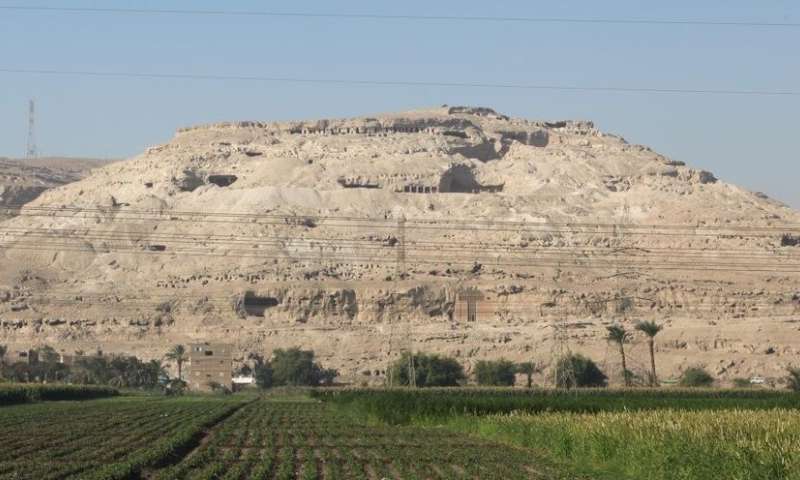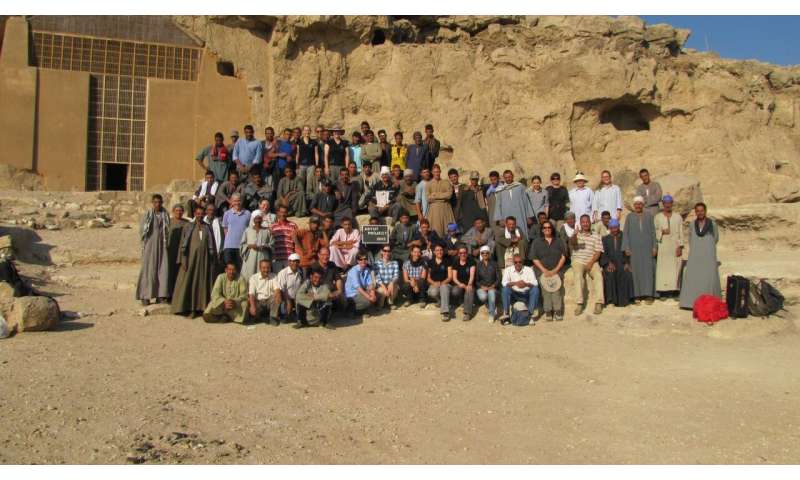https://phys.org/news/2020-02-necropolis-asyut-important-element-egypt.html
The necropolis of Asyut as an important element of Egypt's cultural memory

View of Gebel Asyut al-gharbi Credit: Fritz Barthel
About 4,000 years ago, Asyut was an important cultural center in Middle Egypt. The ancient city with its temples, palaces, libraries, and houses later disappeared under Nile flood sediments and modern construction, which is why its sights have never become as popular as those in Thebes or Luxor. Quite the reverse: Until recently, little was known about the history of ancient Asyut, while the large city has not been highly regarded in modern Egypt.
But this picture is changing thanks to a joint German-Egyptian project that has thoroughly investigated the necropolis in the mountain of the Gebel Asyut al-gharbi in the west of the city. The project that ran for 16 years has been shedding light on the monumental royal tombs, shaft tomb complexes, diverse ceiling paintings, colorful wall decorations, endless inscriptions, and grave goods. "The finds broaden our knowledge about the history and art of a region that experienced a cultural and economic boom during the First Intermediate Period and the period of the Middle Kingdom," said Professor Ursula Verhoeven-van Elsbergen of Johannes Gutenberg University Mainz (JGU). "Asyut, consequently, has a significant role to play in Egypt's cultural memory."
Together with Professor Jochem Kahl from Freie Universität Berlin, Verhoeven-van Elsbergen led the project in close cooperation with researchers from Sohag University in Egypt. Over 14 field seasons, the international and interdisciplinary team worked for two months each summer on the mountain complex, which was reopened for archaeological fieldwork by the Egyptian Ministry of Antiquities for the first time in 80 years in 2003. The first documentary record of individual graves dates from Napoleon Bonaparte's Egyptian campaign in 1799. Shortly afterwards, quarrying work resulted in the collapse of tomb ceilings and entrances. Tomb robbery and archaeological excavations in the 19th and early 20th century led to the plundering of the mountain. Valuable burial objects found their way into museums all over the world, mostly without sufficient description of the context in which they were found.
The project created the first map of the necropolis with over 300 entries
The large nomarchs' rock tombs of the western desert mountain of Asyut were constructed in the First Intermediate Period and the Middle Kingdom, i.e., approximately 2200 to 1900 BC. However, the 200-meter-high limestone massif was also the site of Christian and Islamic burials after the Pharaonic Period. It was also a burial site for animals, an ancient and early modern quarry, a destination for excursions, a retreat for hermits, the site of Coptic monasteries, and, most recently, a decade-long, restricted military area.
Reopening of access enabled the first scholarly investigation of the mountain, which was supported by long-term funding from the German Research Foundation (DFG) and accompanied by agents of the Egyptian Ministry of Antiquities. From the outset, the team worked on creating the first map of the necropolis, which now identifies over 300 tombs and other structures. More than 17,000 finds have been cataloged.

The international Asyut project team. Credit: Fritz Barthel
An unknown grave yields numerous new insights
In 2005, based on a suggestion from a local guard, the project discovered an almost completely buried, hitherto entirely unknown rock tomb constructed by the provincial governor Iti-ibi-iqer in approximately 2000 BC. "Tomb N13.1 was constructed during a time of political upheaval and is therefore historically important, but it also contains well-preserved and unusual wall decorations," said Verhoeven-van Elsbergen. These include portrayals of the tomb owner and his immediate relatives as well as of divine beings, columns of soldiers, and scenes depicting craftwork, cattle breeding, hunting, music, and dance. Particularly noteworthy are the 215 ink graffiti made by visitors 500 to 900 years later. They include praise of the local temples, writing and drawing exercises, and extensive excerpts from prominent teachings, which until now had almost exclusively been preserved from Thebes. The longest of these texts, the Teaching of Hordjedef, extends over several walls, is eleven meters in length, and opened up important insights into the history of literature.
The information in the visitors' texts about persons, deities, and temples at Asyut in the New Kingdom (about 1550-1070 BC) is particularly valuable since the cemetery of this era has not been discovered yet. "They're often wonderful texts. One unique example is a song that describes in imaginative comparisons and in several stanzas the beauty of the face of the local goddess Hathor," said Verhoeven-van Elsbergen. The Mainz-based egyptologist is an expert in Hieratic, the cursive script in which these texts are written. Some, however, are barely legible. Requiring detective work and comparison with a large number of similar texts, the script must be deciphered, transcribed into standard hieroglyphics, translated, and finally interpreted. Members of the project took photographs, made hand copies, and digitally documented the entire graffiti with its texts and drawings of men and animals.
The largest tomb of its time was 120 meters long, up to 11 meters high, and extended downwards 28 meters
The discovery of previously unexplored burial shafts was another highlight for the members of the project. These are architecturally unique and include a 28-meter deep shaft, which was only fully excavated after six seasons. This burial site, called Tomb I, belongs to the provincial governor Djefaihapi I (approx. 1900 BC) and is the largest tomb on Gebel Asyut al-gharbi, scheduled to be opened for tourists this year. It is the only known tomb of a high-ranking official of such a size from this period. In its original form it was at least 120 meters long and is still preserved today over a length of 55 meters, with ceilings up to 11 meters high. The interior of the rock tomb is decorated with paintings and inscriptions carved in stone. Many of these texts continued to circulate in Egypt for more than 2,000 years—a testament to the esteem in which Asyut was held as well as its theological importance and the linguistic quality of its inscriptions.
Close collaboration with the project's Egyptian partners contributed to its success
Project director Verhoeven-van Elsbergen describes the collaboration between the groups from Mainz and Berlin with colleagues from Sohag University, who were actively involved in the project from the start, as unique. The team consisted of about 25 researchers from around the world and up to 100 local workmen. Their main task was to remove high mountains of rubble and debris from the excavation sites.
"The significance of the city has been reestablished, thanks to the field studies at the necropolis and our cataloged work," emphasized Professor Ursula Verhoeven-van Elsbergen. "We have reinstated the role of Asyut in Egypt's history." Instrumental to this success was the fact that the project considered the mountain's entire history, from thousands of years ago to the present day: the large-scale dog burial from the late first millennium BC, the settlement by Coptic monks and hermits, the building of monasteries, Islamic burials, and, last but not least, the perspectives of the local workmen, which were also the subject ethnological research.
The project has published its findings in its own ongoing series of volumes, twelve to date, entitled The Asyut Project. As part of its long-term funding, the German Research Foundation supported the project until the end of 2019 with a total of EUR 3.5 million. But the work is still ongoing. Professor Jochem Kahl has already secured a follow-up project in cooperation with the Polish Academy of Sciences under the title "Asyut—an ancient trading center." Professor Ursula Verhoeven-van Elsbergen heads the long-term project "Ancient Egyptian Cursive Scripts" at the Academy of Sciences and Literature in Mainz, in which scripts, including those from Asyut, are processed and made accessible in a digital paleographic database. This academy project was launched in 2015 and will run for 23 years.
-- Sent from my Linux system.
No comments:
Post a Comment